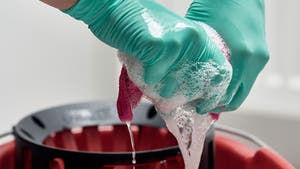The Importance of Cleaning and Disinfecting to Prevent HAIs Beyond COVID-19
The past two years of battling against the COVID-19 pandemic has weighed heavily on healthcare workers and infection preventionists. While our attention has focused so much on COVID-19, there is a continued need to find a sustainable approach that allows infection preventionists and healthcare facilities to address healthcare-associated infections (HAIs).
According to the Centers for Disease Control and Prevention (CDC) on any given day, one in thirty-one hospitalized people will have at least one HAI. This number is likely underrepresented, as some HAIs are not reportable or identified properly. Coupled with the ever-changing threat of antimicrobial resistance (AMR), it is critical that healthcare facilities target their infection prevention measures to address all relevant pathogens.
During the first few months of the pandemic, we were trying to put out the fire that was COVID-19. Guidance changed in waves and we were trying our best to simply stay afloat. Slowly, we started to notice trends – patients hospitalized with COVID-19 were often given or required antibiotics and/or had prolonged hospital stays. From central-line associated bloodstream infections to drug-resistant urinary tract infections, it became apparent that hospitalized COVID-19 patients faced a real risk of HAIs and multi-drug resistant organisms (MDROs).
In my experience, HAI prevention has always been a hurdle and the COVID-19 pandemic only exacerbated this issue. From ensuring proper protocols are followed to making sure personal protective equipment (PPE) is worn, to ensuring proper and effective cleaning and disinfection. While the focus for COVID-19 has moved to a more holistic approach that still incorporates daily cleaning and disinfecting, the over-correction we saw with COVID-19 prevention initially trickled into healthcare. While we now know that COVID-19 is primarily spread through shared air, cleaning and disinfection remains important as part of the holistic prevention strategy.
However, the amount of attention put on enhanced cleaning in the early days of the pandemic can send the wrong message about the importance of this prevention strategy across the board. There are many times we absolutely need to perform enhanced cleaning and disinfection — consider C. diff or a hardier organism, like a highly resistant C. auris. Both require us to ensure the products being used are effective and we’re properly following contact time directions. Just because COVID-19 may not require enhanced cleaning and disinfection, which is a good thing, doesn’t mean that other organisms are going to let up also. As a result, now more than ever, we are working to re-align healthcare and infection prevention efforts to include a sustainable approach that allows us to focus on COVID-19 in addition to the daily threat of HAIs.
Too often the daily cleaning and disinfection is forgotten in the hectic world of healthcare. Running a million miles a minute, it can seem like there is no time for the cleaning of a bed-side table or knobs of medical equipment. These though, are the times and situations we must continue to be vigilant. In fact, each year in the United States, there are 2.8 million antibiotic resistant infections and as a result, 35,000 people die – we can’t afford to forget about MDROs, even if we’re in the midst of a pandemic. For example, healthcare continuously struggles to contain HAIs. In fact, much of the progress we’ve been working towards with HAIs has plateaued and slowed during the COVID-19 pandemic. While we’ve made some gains in reducing C. diff, we still struggle to bring these preventable infections to zero. C. diff, in particular, is preventable by both proper antibiotic use and proper infection prevention efforts including cleaning and disinfecting and use of PPE. Cleaning and disinfection, both routine and in high-risk situations, is one of the most basic forms of infection prevention we can undertake.
It’s not so simple though to reiterate the importance of doing the cleaning and disinfection, but also consider several factors – like correct product selection for the organism. C. diff is a prime example of why we work to ensure there are enhanced cleaning and disinfection protocols. We want to ensure staff have easy access to a sporicidal or bleach-based product but are also aware of how to properly use the product and follow contact times appropriately. It can be helpful to incorporate reminders of proper use or effective products on isolation signage. Such efforts reduce the risk of exposure to seasonal organisms like influenza and norovirus, but also MDROs and those we often see in hospitalized patients causing infections.
Unfortunately, I have seen HAIs that occurred as a result of poor cleaning and disinfection, which led to further antibiotic use, longer hospital stays, and a transition to an MDRO, underscoring the importance of this basic infection prevention effort. As the world tries to normalize post-pandemic, the role of cleaning and disinfection has increased in importance. Our ability to maintain continued efforts and follow protocols will make the difference between infections in patients and staff alike, but also the future of antimicrobial resistance. Now is the time to build up the infection prevention toolbox with everything from appropriate products for the task at hand to education resources to the most effective cleaning and disinfecting protocols — all things you can find on cloroxhealthcare.com


